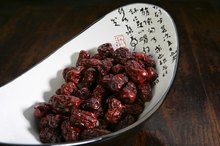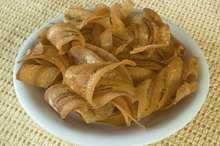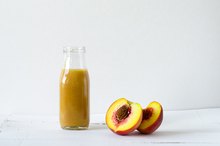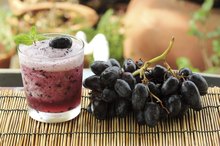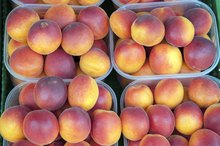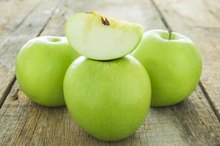How to Stop Fruit Oxidation
Fruit oxidation is the result of cell damage in thin skin fruits such as apples, peaches, pears and bananas. Oxidation starts when peeling, slicing or rough handling causes cell membranes within the fruit to rupture and release an enzyme called polyphenoloxidase. The characteristic brown color that develops on the surface of the fruit is an organic compound that forms when polyphenoloxidase mixes with oxygen. While you cannot prevent fruit oxidation from ever occurring, you can buy time by giving oxygen something else to work on before it starts working on your fruit.
Brush smaller pieces of sliced fruit, such as bananas, with lemon-lime soda, or lemon, lime, orange or grapefruit juice. Oxygen will first turn its attention to the citric acid in the soda or juice as it undergoes oxidation at a faster rate than your fruit.
How to Reconstitute Dried Fruit
Learn More
Soak whole or large slices of fruit, except for bananas, for up to 15 minutes in mixing bowl that contains a solution of 1/4 cup citrus juice or cider vinegar and 1 qt. of cold water. This mixture works by making the surface of the fruit less acid and by allowing less oxygen to mix with the fruit slices 2.
Crush a 500 mg tablet of vitamin C and let it dissolve in 1 gallon of water before adding sliced fruit 1. Ascorbic acid, a component in vitamin C, will stop oxidation from occurring. This method is a good choice when you are slicing large amounts of fruit, as it will not affect taste 1.
Tips
Always handle thin skin fruit with care. Rough handling or dropping a piece of fruit can cause small tears in the skin and start the process of oxidation.
Related Articles
References
- Scientific American: Why Does Bruised Fruit Turn Brown
- Recipe Tips: Why Fruits and Vegetables Turn Brown
- Rizkalla SW. Health implications of fructose consumption: A review of recent data. Nutr Metab (Lond). 2010;7:82. doi:10.1186/1743-7075-7-82
- Du H, Li L, Bennett D, et al. Fresh fruit consumption in relation to incident diabetes and diabetic vascular complications: A 7-y prospective study of 0.5 million Chinese adults. PLoS Med. 2017;14(4):e1002279. doi:10.1371/journal.pmed.1002279
- Wannamethee SG, Whincup PH, Thomas MC, Sattar N. Associations between dietary fiber and inflammation, hepatic function, and risk of type 2 diabetes in older men: potential mechanisms for the benefits of fiber on diabetes risk. Diabetes Care. 2009 Oct 1;32(10):1823-5. doi:10.2337/dc09-0477
- Silva FM, Kramer CK, de Almeida JC, Steemburgo T, Gross JL, Azevedo MJ. Fiber intake and glycemic control in patients with type 2 diabetes mellitus: a systematic review with meta-analysis of randomized controlled trials. Nutr Rev. 2013;71(12):790-801. doi:10.1111/nure.12076
- Wang PY, Fang JC, Gao ZH, Zhang C, Xie SY. Higher intake of fruits, vegetables or their fiber reduces the risk of type 2 diabetes: A meta‐analysis. Journal of Diabetes Investigation. 2016 Jan;7(1):56-69. doi:10.1111/jdi.12376
- Huang H, Chen G, Liao D, et al. Effects of berries consumption on cardiovascular risk factors: A meta-analysis with trial sequential analysis of randomized controlled trials. Sci Rep. 2016;6:23625. doi:10.1038/srep23625
- Muraki I, Imamura F, Manson JE, Hu FB, Willett WC, van Dam RM, Sun Q. Fruit consumption and risk of type 2 diabetes: results from three prospective longitudinal cohort studies. BMJ. 2013 Aug 29;347:f5001.
- Harvard Health Publishing. Use glycemic index to help control blood sugar. Updated Aug. 13, 2012.
- Koloverou E, Panagiotakos DB. Macronutrient composition and management of non-insulin-dependent diabetes mellitus (NIDDM): A new paradigm for individualized nutritional therapy in diabetes patients. Rev Diabet Stud. 2016;13(1):6-16. doi:10.1900/RDS.2016.13.6
- Hosseini B, Berthon BS, Saedisomeolia A, Starkey MR, Collison A, Wark PA, Wood LG. Effects of fruit and vegetable consumption on inflammatory biomarkers and immune cell populations: a systematic literature review and meta-analysis. The American Journal of Clinical Nutrition. 2018 Jul 1;108(1):136-55. doi:10.1093/ajcn/nqy082
- Cooper AJ, Sharp SJ, Lentjes MA, Luben RN, Khaw KT, Wareham NJ, et al. A prospective study of the association between quantity and variety of fruit and vegetable intake and incident type 2 diabetes. Diabetes Care2012;35:1293-300. doi:10.2337/dc11-2388
- Basu A, Rhone M, Lyons TJ. Berries: emerging impact on cardiovascular health. Nutr Rev. 2010;68(3):168-177. doi:10.1111/j.1753-4887.2010.00273.x
- Mahmoud AM, Hernández Bautista RJ, Sandhu MA, Hussein OE. Beneficial effects of citrus flavonoids on cardiovascular and metabolic health. Oxid Med Cell Longev. 2019;2019:5484138. doi:10.1155/2019/5484138
- Centers for Disease Control and Prevention. Carb Choices. Updated March 21, 2019.
- American Diabetes Association. Glycemic index and diabetes.
- Wang PY, Fang JC, Gao ZH, Zhang C, Xie SY. Higher intake of fruits, vegetables or their fiber reduces the risk of type 2 diabetes: A meta‐analysis. Journal of Diabetes Investigation. 2016 Jan;7(1):56-69. doi:10.1111/jdi.12376
Writer Bio
Based in Green Bay, Wisc., Jackie Lohrey has been writing professionally since 2009. In addition to writing web content and training manuals for small business clients and nonprofit organizations, including ERA Realtors and the Bay Area Humane Society, Lohrey also works as a finance data analyst for a global business outsourcing company.
